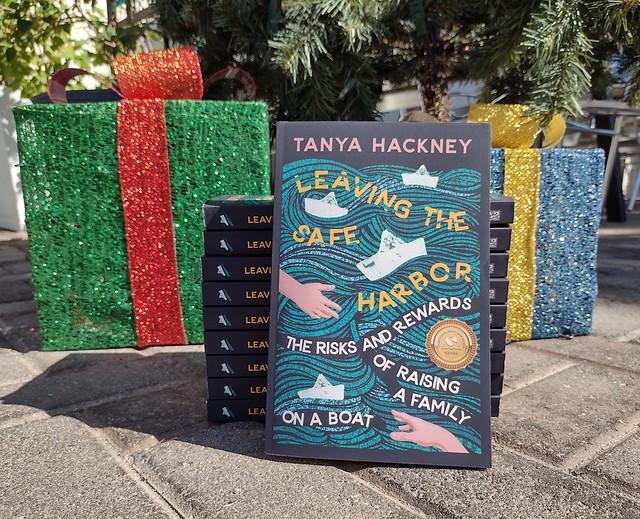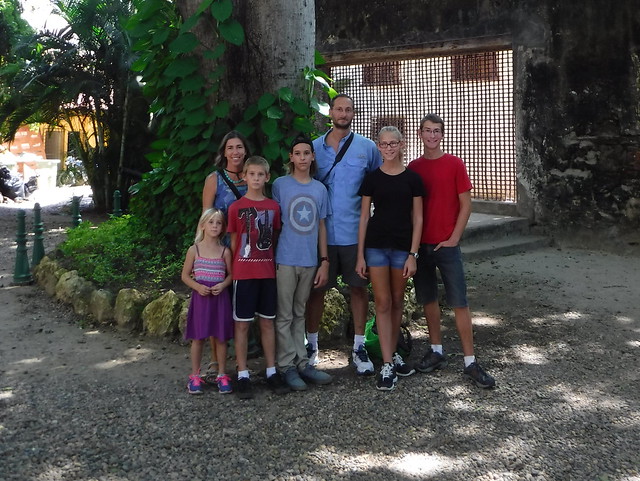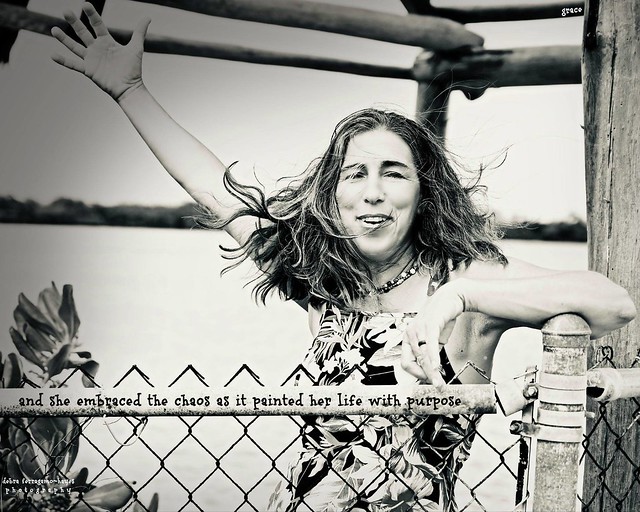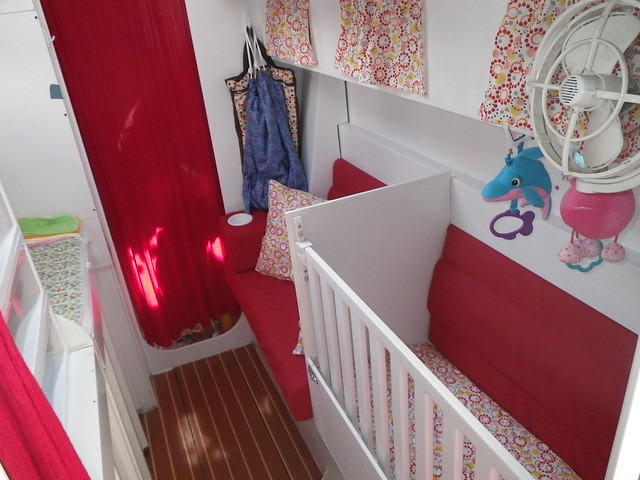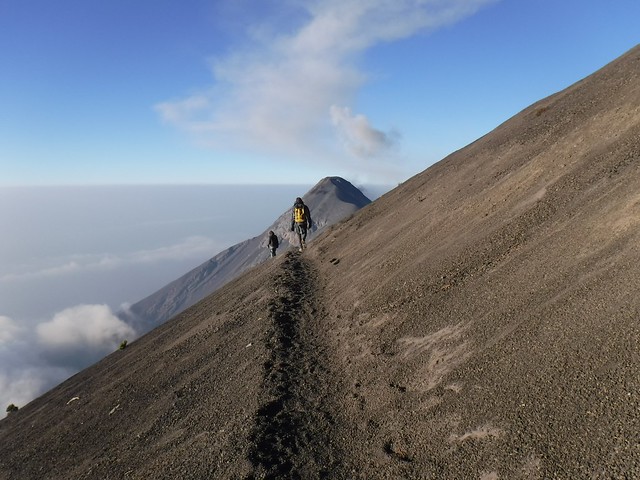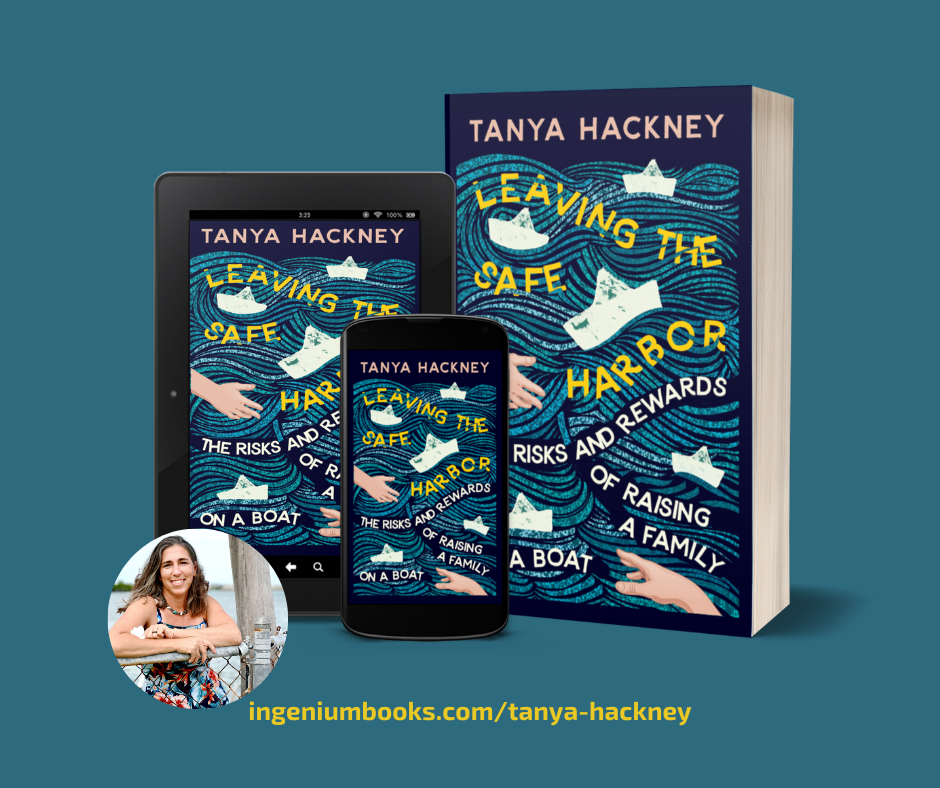This is the text of the speech I prepared to give at the Marathon Library Tuesday, March 1, for those of you who couldn’t be there but want to know what I said. Of course, after the first five minutes, and knowing most of my audience, I went off-roading and barely looked down at the outline on my notecards. So this isn’t exactly the talk that I gave!
I. Welcome and Introduction
Good evening, welcome, and thank you for coming. My name is Tanya Hackney: I am a graduate of Middlebury College in Vermont, a wife to my high school sweetheart, Jay, and mother to five children (Eli, age 20, Aaron, 19, Sarah, 17, Sam, 15, and Rachel, 10). I am a public-school teacher who shifted to homeschooling my own children aboard a 48’ sailing catamaran, Take Two, in 2008. I’m a liveaboard sailor, a ukulele player, and a writer. My book, Leaving the Safe Harbor: the Risks and Rewards of Raising a Family on a Boat, was published in October of 2021, and much to my surprise, won several awards and spent some time on Amazon Best Seller lists.
This evening, I want to give you a little “behind the scenes” tour of my book—where I come from, what it’s about, and why I wrote it. For about 25-30 minutes, I’d like to talk about what it means to “leave the safe harbor,” to find the adventure life offers, overcome the fear that holds us back, learn to live now so we won’t have regret later, and to keep the promises we make to ourselves. At the end, we’ll have some time for a Q&A, and then if you would like to purchase a copy of my book, I will be signing them and giving a portion of the proceeds to the library.
I’d like to begin with two quotes, first, Marcus Aurelius (the Roman Emperor and Stoic Philosopher):
“It is not death that a man should fear, but he should fear never beginning to live.”
And next, Oscar Wilde: “To live is the rarest thing in the world. Most people exist, that is all.”
II. A Vicarious Journey
I would like to take you with me on a vicarious journey. You won’t need a ticket, a passport, a suitcase, money, or a PCR test! We’ll travel back in time, into the future, through the minefield of the human psyche, over land and sea, and to distant islands—from right here in Marathon, Boot Key Harbor, and back again. All you need is a good imagination.
Buckle your proverbial seatbelts, close your eyes, and open your minds. In your thoughts, I want you to turn around and run back in time. Run as fast and as far back as you need to in order to find a happy childhood memory. Can you see yourself in this memory? Reconnect with this younger version of yourself. Introduce yourself, shake hands, tell this young you that you are here with an important question.
Ask yourself: “What do you dream about?” Not your night-time dreams or nightmares, but the deepest desires of your heart, your hopes for the future—the thing you think about when you’re supposed to be reading your history book or doing your math homework. What do you really want out of life? The answer might sound silly to your older, more jaded self, but try to listen without judgment or laughter. Do you have the answer? Thank your young you…and open your eyes.
Hold onto that answer, that dream you once had—or maybe still have—and take it with you on the next leg of your journey. You’re going to stow away with me, travel the world, get a glimpse of life on a sailboat with a large family, and explore the treacherous waters of fear and regret.
III. Travel Memories
My earliest memories involve travel. My dad had a unique job: he was in urethane foam construction and coatings. We lived in one of those funky foam dome houses in the mountains of Colorado in the 1970s (think Woody Allen’s The Sleeper). My dad traveled all over the world working on interesting projects like the Sydney Opera House, dome constuction in the desert of Saudi Arabia, and the roof of the Chiang Kai-Shek Airport in Taipei, Taiwan. He brought back amazing gifts and coffee table books with photographs that my siblings and I would pore over.
When he finished the roof of the Chiang Kai-Shek airport, I was four years old. My sister was two, and my mom was pregnant with my baby brother. When he called to say that he wouldn’t be home in time for the birth, my brave mother got on an airplane eight months pregnant with two little girls in tow, and went to live in Taiwan, having a baby in a hospital where no one (not even her doctor) spoke English. My earliest memories are of that time: going to the fish market, learning to use chopsticks, eating sugar apples, standing in a doorway during an earthquake, and the monsoon season during which our house flooded and my dad served us breakfast on the stairs with his pants rolled up to his knees.
When we returned from that trip, my dad decided he needed to find domestic work to support our family. As an independent contractor, it was feast and famine. His business was affected by weather, the rise and fall of local economies, and the clients he worked for. But even when we were struggling financially, travel was always a priority. We couldn’t afford to fly, so we drove. We couldn’t afford hotels, so we stayed with family or camped in tents. I have wonderful childhood memories of mountains, deserts, coastlines, forests, waterfalls, farmland, big cities, small towns…we camped in Rocky Mountain National Park, peered into the Grand Canyon, went to Yellowstone, and slid down the Great Sand Dunes. We stopped in Washington D.C. and New York City on our way to Niagara Falls. We drove to California, went to Disneyland, and toured the Queen Mary.
These early travels are not just the things of memory, but also shaped my dreams of the future, too. You could say that the travel bug bit early. Whatever I would do with my life, I knew it would involve travel. When I went to college, I studied English and French. I chose a college with a good study-abroad program and spent a semester in France taking classes at the University of Paris. On weekends, I took the train to Normandy, London, and the Loire Valley to see the Chateaus. I spent a Christmas break with family friends in Italy, Switzerland, and Sardinia. It was amazing, but hard on the long-distance relationship with my boyfriend back home.
When I got back, we got engaged. I graduated from college in June of 1997 and we married in August. Jay is the son of a son of a sailor, seventh generation born in Florida. He spent his childhood sailing with his family, exploring the ten thousand islands, Everglades National Park, the Bay of Florida, and the Florida Keys. We honeymooned in the Yucatan of Mexico—rode horses through the jungle, snorkeled in crystal-clear water, and climbed the great pyramid at Chichen Itza. We loved every minute and said we’d come back someday. (We did eventually return—on our sailboat, with our children, in 2019).
When we had been married for about a year, Jay’s parents invited us to go on a sailing trip with them. We took off on an adventure on their Prout Quest 31-foot catamaran, Double Entry. We sailed overnight to Dry Tortugas National Park and then on to Key West before returning to Naples, Florida. It was a typical sailing trip—sunsets at sea, clear blue water, snorkeling, exploring, long talks, starry skies, and, of course, storms and breakage! On the return trip, I made a terrible mistake that led to a terrific revelation. We were motor-sailing away from Key West in light wind when I clumsily broke a fitting on the fuel tank that connected it to the outboard engine. Though Jay and his dad got it jury-rigged and running again, they couldn’t get the engine back in gear because of a previous transmission problem, and so we were forced to sail all night over calm seas and call for a tow when we reached Naples. I sat up in the cockpit all night—amazed by the stars and the phosphorescence in the water. Had it not been for my little blunder, I might not be standing here today. That beautiful night sail was the spark that lit a smoldering fire—one that burned for years until we were able to break away, buy our own boat, and travel with our family. It was on that trip that I knew what I wanted to with the rest of my life.
IV. Easier Said than Done
It is easy for me now, standing here in this library, having traveled for more than a decade aboard our boat, having successfully homeschooled our children from kindergarten to high school, having written a book about the experience, to talk pithily about overcoming fear to follow a dream, but there was nothing easy about doing those things. In fact, every aspect of turning an idea into reality is fraught with difficulty, from figuring out what you want to do and how to do it to overcoming the inevitable obstacles that crop up. And these driving questions which I had to answer, I also ask you:
- What do you really want and why do you want it? (You will have to find a vision for yourself that is so clear you can imagine all the details and see yourself in it.)
- How will you get it? (You will have to figure out the million tiny steps that take you in the right direction.)
- How badly do you want it? (You will have to put so much faith in that idea that you never give up, that you overcome all your excuses and fears and surmount any obstacle that gets in the way.)
It’s a herculean task, but worth doing or dying in the attempt. Here’s what’s easy: going along with the crowd, doing what’s expected of you, following the status quo, letting your life slip by one day at a time until it seems like it’s too late to do the things you really wanted.
When attempting something difficult, but worthwhile, sometimes the hardest thing is getting over our own fears. We often ask “what if…?” In my case, going sailing seemed impossible. How could we afford a boat? What if we bought one and then hated it? What if it broke? What if we ran out of money? What if we want to have a family? What if we encounter storms at sea, sharks, or pirates? What if we sink? What if we fail? Fear doesn’t seem to know the difference between life-threatening and comfort-threatening.
What we don’t do, but should, is ask the other “what if…” questions. What if it’s amazing? What if we love it? What if we get to live a life of travel and adventure? What if we could take our kids sailing? What if we make great memories, learn new languages, and meet other travelers? What if we don’t try and later regret it? Following our dreams gives life a sense of purpose and direction and helps us step out of a safe and boring life and into one of adventure and fulfillment. We need our dreams, no matter how crazy or impractical they seem, to keep us from stagnating. If, by some amazing combination of determination and circumstance, you too have followed a dream to its exciting conclusion, you know exactly what I am talking about.
I promised you a journey through space and time, through landscapes both real and metaphysical—and I will keep that promise, at least in part. To get the whole story in all its detail, you’ll have to read the book, but I can give you a glimpse of my own dream-come-true, and the things we have learned from chasing a crazy dream.
The adventure begins in an unlikely place: a suburban house with a white-picket fence. After we married, Jay and I moved to Atlanta and got regular jobs. We loved the idea of sailing off into the proverbial sunset, but we were sensible people, so we did what everyone else around us was doing: we went into debt, bought new cars, bought a house, bought furniture, worked all the time to pay bills, and then started a family. It’s the American Dream! We should have been satisfied, but, oddly, we felt unfulfilled.
Jay was sitting in traffic for hours each day, I had quit my teaching job (which I loved) to stay home with two boys under the age of two (up to my elbows in poopy diapers). We bought a mini-van when I got pregnant with our daughter and Jay acquired a weekend car, a Porsche Boxster. We had been talking about moving to a nicer neighborhood with better schools, but we began to feel uneasy. Where were those young people who wanted to go on a sailing adventure? Where was the romance and travel that I had dreamed of? Taking annual trips to visit family with small children in tow was not my idea of “exotic.” We were doing all the things we were supposed to do—working hard, raising kids, going to church, paying our bills, putting money away for college and retirement—but something was missing.
There was nothing wrong with the things we were doing—the “have-tos” are a necessary part of life. But whole days, weeks, months, and years were zooming by and we were in danger of becoming entrenched in a safe and boring life. Under the yuppie veneer, we were still longing for more adventure, more challenge, more freedom. Our restlessness led us to re-examine the direction we were heading. Jay was on a sailboat race crew on Lake Lanier. We subscribed to sailing magazines and talked about leaving Atlanta, but it seemed impossible.
The story of how we broke free and left our suburban trap is a good one, a roller coaster ride of ups and downs and twists and turns, one that took a lot of faith, courage, and stubborn determination. In brief, we almost bought a bigger house in a nicer neighborhood, but at the last moment, we realized that what we really needed to do was downsize, move back to Florida, and trade the sports car for a sailboat. We prayed a lot during that transition, trying to determine what God’s plan for our lives was. We wanted not just what felt comfortable, but what would grow and stretch us. The faith we developed during that time is what gave us the courage to do all the things that came next.
V. Practical Steps
It is one thing to have a dream—you’ve got one with you right now! And another to make it reality. Without practical steps, it remains in the realm of castles in the air. In a nutshell, these are the things we did to change our trajectory: we got out of debt. We had made a plan before we had children that one of us would stay home, so we had learned to live on one salary and use the other to pay off debt. When we lost my salary, we lost the gravy, but not the meat and potatoes. We decided to homeschool our kids so that we wouldn’t have to yank them out of a “normal life.” We sold our Atlanta house and downsized. We made a five-year plan.
We moved to Florida, sold the sports car and bought a small sailboat to practice sailing on Tampa Bay. Jay took his job in database engineering and consulting and moved it to a home office that could eventually be taken anywhere. We saved money to buy a bigger boat, trading stuff now for adventures later. We went to boat shows and read everything we could get our hands on. We looked at a Tayana ’55 and almost bought it, but we were expecting a fourth child and felt really nervous about taking the leap. We learned from that failure and put ourselves in a position of receptivity and readiness, surrounded ourselves with supportive people, and cut out things and people that did not propel us forward. Just after Sam was born, Jay found Take Two—our second chance! It was a catamaran, bigger, more stable, perfect for our growing family, so we bought it. Within a year, and just hitting the end of our five-year plan, we had moved aboard, sold most of our belongings, and put our house on the market. We took day trips, then weekend trips, then a week-long thanksgiving trip, and then, after selling the house, we left!
Of course, summing it up this way makes it sound easy, but it was hard—hard to face our own doubts and fears, hard to go against societal norms, hard to make what seemed like an unwise financial decision, hard to live in a small space with lots of small children, hard to fix the boat and learn to sail it, hard to untie the dock lines and leave the safety of the known for the unknown adventure. But one thing propelled us forward: the possibility of regret. We knew a lot could go wrong with our plan, but we also knew that if we didn’t try, we would always wonder what it would have been like. We did not want to wait, because life is unpredictable and if we didn’t take the chance when we were young and capable (and a little crazy), we might not get another opportunity. Most importantly, we did not want to die with regret—wishing we had done things differently.
VI. Travels
When we set off into the proverbial and literal sunset—we sailed back to the Dry Tortugas. It was our first overnight, and we had aboard an 8, 7, 5, and 3-year-old. When you travel with small children, you are always single-handing; one person is on-watch and the other person is responsible for the safety and comfort of the kids. When we arrived the next morning just in time to see the sea plane touch town near Fort Jefferson, we felt a rush of excitement and accomplishment. We had made it! We were cruising with our family! We set the anchor and all jumped in for a swim. That week was so much fun—touring the old fort with our kids, snorkeling, going exploring in the dinghy, learning how to be truly self-sufficient. We sailed to Key West and did some sightseeing—introducing our children to the historic southernmost city. And then we made our way to Marathon and motored into Boot Key Harbor.
If you are sitting here, you probably know what a special place Marathon is. There are many metaphorical “safe harbors” that we have had to leave in order to live an adventurous life, but Boot Key Harbor is the literal safe harbor where we really began our journeys. It was where we first met the community of cruisers and liveaboard sailors, where we learned to provision by boat, to manage our power and water usage, and to take care of chores and repairs while living on a mooring ball. We met a colorful cast of characters that call this place home and made friends in the homeschool community. It was where we learned to get comfortable with discomfort. I learned I was expecting a baby in the summer of 2010—and we lived on a mooring for about six months until we could get our boat ready to cross the Gulf Stream in November. It was hot and buggy and I was pregnant! We knew we only had a few months before we would need to be in a stable place for the birth of our baby, so ready or not, we left the safe harbor and set off for the Bahamas.
It was everything we had hoped for and everything we had promised our kids—white sand beaches, palm trees, snorkeling, water that looks like a bottle of Sapphire Gin, and lots of other boats with families. There were also challenges and opportunities to learn from mistakes. We felt like we had finally “arrived”…we were doing the thing we had always dreamed of, and it was worth all the trouble to get there. Of course, just as we were beginning to get comfortable with the cruising life, it was time to decide where to stop and have a baby.
One thing we had learned while traveling is that our boat was not very “kid-friendly.” In addition to needing a physical space to put the new baby, we also needed to re-do the upholstery, update the galley, add a head (we were all sharing a single hand-pump jabsco toilet!), and generally make the living space more comfortable. After more than a year of living aboard, we had decided we were not camping and wanted to make Take Two our home long-term. So we sailed back to Florida to have a baby and re-fit the boat.
If you can’t imagine having four little kids aboard a boat full-time, then the idea of bringing a newborn baby into that environment will be inconceivable. I won’t lie—it was an intense experience. We spent a year at a marina in Bradenton, Florida, renovating the boat and learning how to manage yet another person in a small space. When you live long-term on a cruising boat, one thing that is really challenging and important to figure out is how to balance living, loving, working, traveling, parenting, and making repairs. We found that alternating seasons of travel with seasons of working to replenish funds and upgrading or fixing the boat worked really well for us. So we have these wonderful travel memories and friendships from all our voyages, and also these moments of stability that allowed us to take care of the demands of homeschooling our kids, making money, fixing the boat, and taking breathers so we would not go crazy.
That baby who was born in 2011, Rachel, is now 10 years old. She has spent her whole life afloat, and she really is a well-traveled and cool little person. Along with our older kids, she has been back and forth to the Bahamas several times, she’s learned American history hands-on and on-location as we traveled up and down the East Coast of the U.S. from colonial cities to Revolutionary and Civil War battlefields, to field trips at the museums of the Smithsonian while we spent a month at the Capitol Yacht Club in Washington D.C. We stopped in Marathon anytime we were on our way past to touch base with friends and enjoy the relative safety of Boot Key Harbor.
In 2016, we set off from here to head to the Caribbean—a trip that gave us more than 20 stamps in our passports and took us 3 ½ years. We spent six months traveling from the Bahamas to Grenada, stopping at almost all the islands on the way down the Eastern Caribbean. After a hurricane season in Grenada, we went west to the ABCs, spending a memorable December in Bonaire, one of our favorite places on planet earth. We spent a lot of time underwater there, but also toured the island, learned to windsurf, went swimming in an underwater cave system, made local friends, and celebrated holidays with boat friends. We took the last weather window of the year just before the arrival of the Christmas winds to sail for Colombia. I will never forget coming around Cabo de la Vela, a place where the wind gets funneled and even on a nice day you can see gusts to 50 knots, and seeing the mountains of the Sierra Nevadas—the snow-capped peaks in South America. We were sailing downwind under a double-reefed mainsail and surfing down 10-12-foot waves, seeing 15 knots of boat speed. It was a wild and exhilarating ride. With our brave crew taking watches, we had sailed to another continent!
We spent a month in Colombia, taking trips to Cartagena, National Parks, the mountains above Santa Marta to see coffee farms and cacao groves, brushing up on our Spanish, and waiting for the wind to abate so we could head further west. We arrived in Panama in January of 2017 and didn’t leave again until January of 2018. Imagine sailing with your family to another country where you don’t speak the language and homeschooling your children in a place where indigenous people paddle by in dugout canoes! It was an incredible experience. We explored the Bocas del Toro archipelago, had a visit with Jay’s parents, traveled overland to Costa Rica, stayed a night in the Chagres River on our way to Shelter Bay where we stayed for a month so we could travel by train along the canal and see the Pacific side from Panama City. We spent a month in the island of San Blas, explored historic Portobelo and reprovisioned for our passage north to San Andres and Providencia (probably our favorite island in all the Caribbean). We spent another year in the Western Caribbean, improving our Spanish, hanging out in Grand Cayman, the Bay Islands of Honduras, learning to free dive in Utila and swimming with whale sharks, exploring Belize, and spending a hurricane season in Rio Dulce, Guatemala. We were able to haul our boat out there for painting and repairs, visit Mayan pyramids, hang out in the ancient city of Antigua, climb active volcanos, hike in the jungle, and swim in ice-cold waterfalls as well as thermal springs.
By this time, our crew was beginning to grow restless. We had left the United States with a 14, 13, 11, 9, and 4-year-old, but during our travels, they had grown from children to young adults. At 17, 16, 14, 12, and 7, they were capable crew-members, seasoned travelers, and Spanish-speakers. We had made lots of friends on other boats, but they were missing friends and family back home. They were beginning to wonder about their own journeys and what the next steps were for their educations and life goals. Though we had pretended that we would just travel around with our kids forever, we knew that a parent’s goal involves working yourself out of a job, and that it was time to come back to our home country and give our teenagers a stable place from which to launch. We exited the Rio Dulce in April of 2019, and headed north to Belize and Mexico. By the first of July, when we motored toward the Florida Keys over seas so glassy they looked like a mirror, we had sailed over 5000 nautical miles in our circle of the Caribbean.
My oldest son was just weeks shy of his 18th birthday, and he had never owned a phone, gone to class, or driven a car. Though we returned to the safe harbor, we were not the same people who had left, and we felt as though we were beginning a different kind of adventure. There was certainly a lot of reverse culture shock! I felt overwhelmed in Publix—everything was so bright, so clean, and so plentiful! Gone were the days of pulling my wagon from the produce stand to the butcher to the street vendor. Gone were the small Caribbean shops the size of a walk-in closet. Gone were the mysterious food items with labels in another language. As happy as I was to come “home,” I also really missed our traveling lifestyle.
Our kids went full-speed into a “normal” life for the first time—the teenagers took standardized tests, started classes at the College of the Florida Keys, learned to drive, got jobs, and hung out with friends. Our younger two joined a community basketball league and reconnected with homeschool friends—and we found ourselves taking multiple trips ashore every day and spending a lot of time zooming around like chickens with our heads cut off! My one consolation was coming back to the boat in the evening to watch the sunset from our peaceful back deck. Some days I just wanted to push the “pause button.”
VII. What We Learned
And then came COVID. You can all thank me (or forgive me!) when that giant “pause button” was pushed. We went from busy-busy-busy to being all seven back on the boat 24-7. It was a rude awakening for many of us, but for me, it was also a confirmation: you never know what can happen, which is why you have to live as if every day is your last! We had not waited until “someday” to travel, had lived outside the box, developed self-sufficiency, and made so many wonderful memories. We had no regrets. And, most helpfully, we already knew how to homeschool!
Like Winston Churchill said, “Never let a good crisis go to waste,” so we used the time provided by COVID to take a long road trip out west and go to all the places you can’t travel by boat—the Grand Canyon, the National Parks of Utah, Rocky Mountain National Park, Mammoth Cave, and the Great Smoky Mountains. I decided to take a manuscript I had been working on and finish and publish it. I did this for three reasons: to relive all the good memories during a time when we were feeling stuck, to reflect on all that we had learned, and to inspire others to live boldly and pursue their wildest dreams.
I’m sure you have questions about some of the difficulties we faced—storms at sea, long passages, close calls, encounters with dangerous animals and people, and how we stayed sane while living aboard with five kids—so I will close with this: the real danger for humans is not the obvious fearful circumstances that we all must face. It is not even death, which is inevitable. It is a life unlived. My daughter has a shirt with Coyote Peterson’s slogan on it: “Be Brave, Stay Wild.” And this is what I want to leave you with. We have safety messaging all around us all the time. But if we follow all the advice given, we will never leave the safe harbor to experience the wild beauty of the world. If we risk little, we gain little. Fear can keep us alive, yes, but it can also keep us from really living.
My book is largely about the risks we took and the rewards we reaped: how sailing is a perfect metaphor for life, how we learned more from failure than success, and how we prioritized relationships and memories over collecting stuff. It is about evaluating risk and living despite our fears—how ordinary people can live an extraordinary life. It explores the physical journeys we took, yes, but also looks at the spiritual journey, the inner voyages of the heart and soul that is the real adventure God offers each of us.
Do you still have that dream you brought with you from the past? It is time to carry it with you into the future. What does your dream from back then tell you about what you want out of life now? What keeps you from pursuing a life full of risks and rewards? If you have already fulfilled a dream, what is your next adventure? What is the next step to getting yourself out of the safe harbor?
Thank you so much for giving me your time and attention this evening. Does anyone have any questions?


